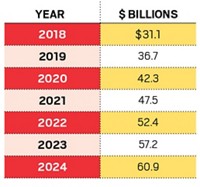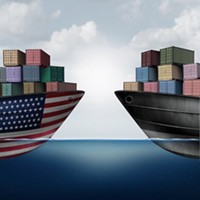Advertisement
Grab your lab coat. Let's get started
Welcome!
Welcome!
Create an account below to get 6 C&EN articles per month, receive newsletters and more - all free.
It seems this is your first time logging in online. Please enter the following information to continue.
As an ACS member you automatically get access to this site. All we need is few more details to create your reading experience.
Not you? Sign in with a different account.
Not you? Sign in with a different account.
ERROR 1
ERROR 1
ERROR 2
ERROR 2
ERROR 2
ERROR 2
ERROR 2
Password and Confirm password must match.
If you have an ACS member number, please enter it here so we can link this account to your membership. (optional)
ERROR 2
ACS values your privacy. By submitting your information, you are gaining access to C&EN and subscribing to our weekly newsletter. We use the information you provide to make your reading experience better, and we will never sell your data to third party members.
Petrochemicals
Caution ahead in petrochemicals
In coming years, petrochemical makers will need to navigate through economic uncertainty, a cyclical downturn, and a plastic waste crisis
by Alexander H. Tullo
April 6, 2019
| A version of this story appeared in
Volume 97, Issue 14

The petrochemical industry is spooked.
Shale gas in the US and a long economic expansion brought a decade of unprecedented prosperity for the industry. But speakers at the World Petrochemical Conference, put on in San Antonio last month by the consulting group IHS Markit, warned of threats to the new order.
Economic growth is slowing, and a recession is possible. The plastic waste issue has blossomed into a full-fledged crisis for the industry that could hamper long-term growth. At the same time, petrochemical makers are bringing heaps of long-planned new production on line, which could mean slack markets in the near future.
In his talk opening the conference, IHS Markit chief economist Nariman Behravesh predicted that US economic growth will slow from 2.9% last year to 2.4–2.5% this year. It should ease further to 2.0% in 2020.
Behravesh told the audience of about 1,500 attendees that he thinks a recession is unlikely. He put the probability of that happening at one in three this year and a little more than that next year. But he cautioned that “as growth slows, the vulnerability to a shock increases.”
Slowing trade, instigated by the Trump administration’s protectionism, has been a sore spot for the US economy. Tariffs have shaved 0.3–0.5% off US growth, Behravesh said. The world economy is also limping from slower Chinese output due to government policies meant to curb freewheeling lending. But with those measures behind it, China is now stimulating the economy with tax breaks and infrastructure spending.
Only human error could crash the economy, Behravesh said. “The single biggest risk facing the US economy is a trade policy mistake,” he remarked.
Petrochemical executives are used to grappling with economic risk, but they haven’t faced public outcry over their products in some time. Now the specter of plastic waste, especially plastic contaminating the world’s oceans, is haunting them. The public is calling for bans on single-use plastics such as shopping bags, straws, and cutlery.
“Plastic waste, I believe, is going to be the sustainability issue of our time,” Jim Fitterling, CEO of Dow Chemical, said.
However, Fitterling lashed out at the raft of new plastics restrictions. “This is a slippery slope, not only because it threatens our industry, but more importantly because these types of misguided policies can actually do more environmental harm than good,” he said.
The sources of ocean plastics, Fitterling said, are rapidly developing countries such as Thailand and China that do not yet have the infrastructure to handle mounting quantities of waste. “The issue is not plastics; the issue is the lack of an effective collection, recycling, and reuse system,” he said.
Moreover, the public can’t lose sight of the benefits of plastics, such as making vehicles lighter and more fuel efficient as well as preserving food. “Modern society is what it is today because of the miracle of plastics,” Fitterling said. “We cannot forget that, but we also can’t forget that plastics waste is a global crisis that needs our attention.”
Bob Patel, CEO of LyondellBasell Industries, struck a more conciliatory tone. “We find ourselves today in a time of disruption,” he said. Already this year, he pointed out, legislative bodies in 21 US states have introduced 133 bills related to plastic waste.
Moreover, Patel cited an IHS scenario of aggressive recycling adoption that could reduce plastics market growth from 4% to 2% annually. “It may change how we think about capital deployment and drive us to embed circularity in our business models,” he said.
“Typically as an industry we would say, ‘Well, let’s do more to explain why plastics are so good for society,’ ” he said. “I think the time has now come to address the issue head-on, rather than to advocate for why we’re great.”
Patel added that the industry tends to think technically about issues, but he warned that plastic waste resonates with the public more viscerally. “Our children are being taught in school that plastics are bad,” he said. “If we don’t do something about this waste issue, then perhaps their teachers are right.”
Both Patel and Fitterling plugged the Alliance to End Plastic Waste, an initiative involving 35 companies with a goal of spending $1.5 billion to combat plastic waste, largely through promoting waste infrastructure and recycling in developing countries. Patel is vice chairman.
Improving recycling in the US will be a challenge in the wake of National Sword, a Chinese government policy launched last year to stem the flow of recyclable plastics from the US. According to Nina Bellucci Butler, CEO of the consulting group More Recycling, about 450,000 metric tons (t) of material has backed up in the US, unable to be exported. New polyethylene capacity being added in the US to take advantage of shale-based petrochemical feedstocks won’t make matters any easier, she said.
“We have a tsunami of material coming on line compared to a droplet of recycling,” Butler said. And without enough places to take recyclables, municipalities are suspending recycling programs. “Collection is slowing and we’ll probably see the first drop in the amount of material collected for recycling,” she warned.
The problem, as Butler sees it, is that it costs more to process postconsumer plastics than it does to buy virgin plastics. “How do we invest in the need to further process the material when there is not enough value to pull it through?” she asked.
As if it didn’t have enough to worry about, the petrochemical industry is also looking at a worsening of business conditions. “Capacity is outpacing demand growth,” said Dave Witte, head of energy and chemicals at IHS Markit.
Chemical demand hasn’t recovered from the Chinese slowdown, trade friction, and economic uncertainty of last year. “We are starting the year weak,” he said.
“There is an overabundance of plastics supply,” Witte added, noting that polymer profits should decline soon, followed by profits for raw materials such as ethylene. Aromatics, which are coming off a strong 2018, should see a dip in earnings as well in coming years as massive new projects to make chemicals such as p-xylene open in China. Bucking the trend, he noted, are chlorine and caustic soda. In that industry, underinvestment may actually force those chemicals into undersupply, causing earnings to accelerate.
Overall, Witte sees chemical profits pulling back from the record levels seen in 2018 of about $150 per metric ton on average. But the $125 per metric ton he forecasts for 2022 profits is “nowhere near historical lows.”
“Trough is a little bit of an extreme word, but we see some dips coming,” said Steve Lewandowski, vice president of olefins for IHS Markit, in his presentation on ethylene.
Global ethylene demand normally increases by 6 million to 7 million t annually, Lewandowski says. With the capacity coming on line, primarily in the US and China, he forecasts new capacity will exceed new demand by about 10 million t overall from 2020 through 2023.
Plant operating rates will decline to 88% from about 91% today—still a high level, Lewandowski noted. Moreover, lower ethylene prices could force some closures, such as older ethylene crackers in China.
Additionally, methanol-to-olefins plants, which produce ethylene and propylene from purchased methanol, will be vulnerable to lower prices and could shutter. Coal-to-chemicals plants that make vinyl chloride and ethylene glycol directly from coal could likewise find themselves under pressure.
“I’m pretty bullish on ethylene even with all the capacity coming,” Lewandowski said, in a remark that was pretty typical of the conference tone overall. Sure, challenges abound, but executives in San Antonio didn’t seem in fear of any existential threats.





Join the conversation
Contact the reporter
Submit a Letter to the Editor for publication
Engage with us on Twitter